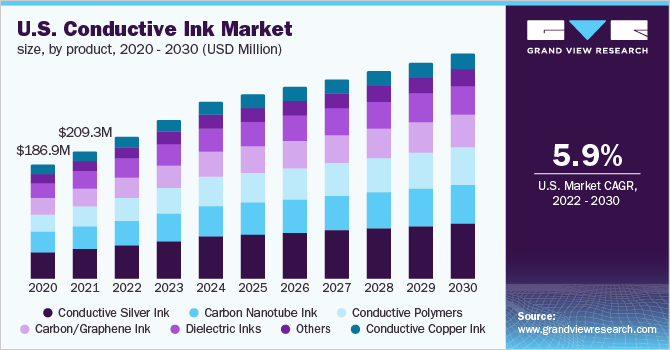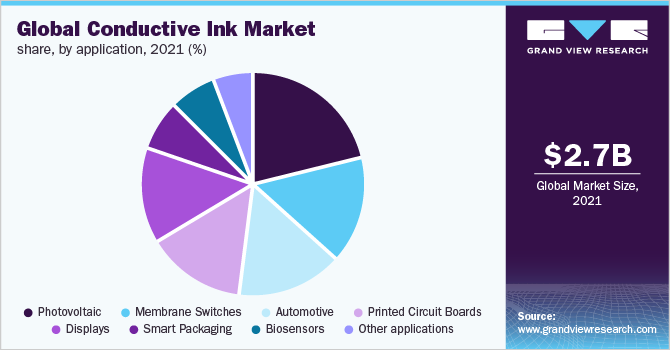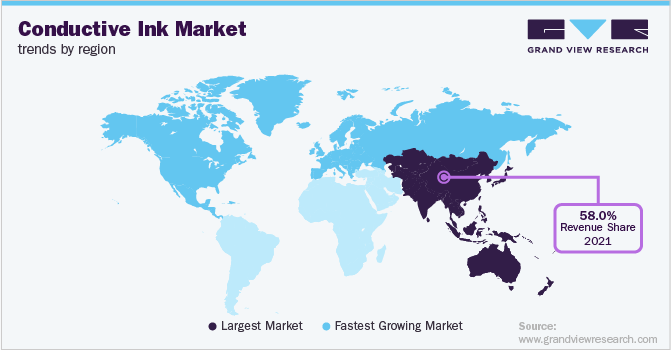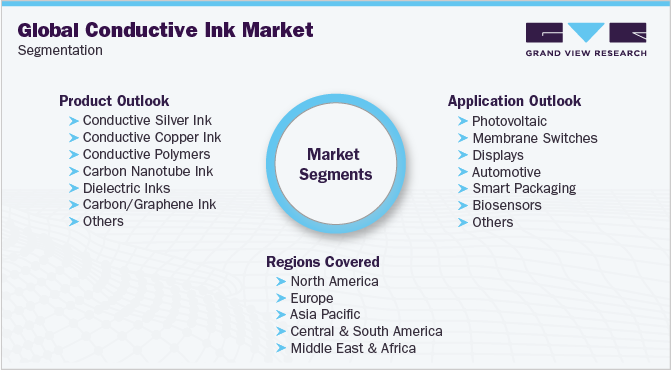- Home
- »
- Paints, Coatings & Printing Inks
- »
-
Global Conductive Ink Market Size & Share Report, 2030GVR Report cover
![Conductive Ink Market Size, Share & Trends Report]()
Conductive Ink Market Size, Share & Trends Analysis Report By Product, By Application (Photovoltaic, Membrane Switches, Displays, Automotive, Smart packaging, Biosensors, Printed Circuit Boards), By Region, And Segment Forecasts, 2022 - 2030
- Report ID: 978-1-68038-982-1
- Number of Report Pages: 125
- Format: PDF, Horizon Databook
- Historical Range: 2019 - 2020
- Forecast Period: 2022 - 2030
- Industry: Bulk Chemicals
Report Overview
The global conductive ink market size was valued at USD 2756.9 million in 2021 and is expected to expand at a compound annual growth rate (CAGR) of 6.0 % from 2022 to 2030. Growth in the market can be attributed to several critical factors such as strong demand from the end-use industries. Possesses certain inherent advantages such as better electrical conductivity and strong resistance to oxidation. Conductive silver ink products find use in markets such as medical devices, consumer electronics, and alternative energy solutions. The products also find applications in polymer thick-film circuitry, EMI, and RFI shielding of polyimide flexible circuits, membrane switches, and coatings for tantalum capacitors. The inks are used on various substrates such as Mylar, Kapton, Polycarbonate, Glass, Polyester, Polyimide, Teflon and Silicone Surfaces, and ITO-coated Surfaces.

Conductive copper ink is used for photonic curing in consumer electronics, radio-frequency identification, membrane touch switch, and antenna applications. The inks are cost-effective in comparison to conductive silver ink. Conductive polymers are used in spin coatings and slot dies coatings. Carbon nanotube ink is used for inkjet printing. In terms of application, the market for conductive ink has been bifurcated into photovoltaic, membrane switches, displays, automotive, smart packaging, biosensors, printed circuits, and other applications. Other applications include batteries, electromagnetic interference, and fuel cells. The conductive inks help in conducting electricity in a printed object.
The photovoltaic application has witnessed a positive trend in the recent past and the trend is projected to continue in the near future. Conductive inks are used in photovoltaic cells, which look similar to solar panels and help in producing steam or hot water. Although the changes in government policies in 2016 in the U.S., China, India, and the U.K. for the surplus PV module installation have slowed the photovoltaic growth rate, conductive inks still hold a major share in the market. The regional market has been segmented into North America, Europe, Asia Pacific, Central and South America, and the Middle East and Africa. The Asia Pacific accounted for more than 58% of the total conductive inks market in 2021 in terms of revenue.
The region is expected to witness a similar trend followed by Europe and North America over the next eight years. Countries such as China and Japan accounted for a significant share of the market. Application segments such as batteries, sensors, and automobiles are presumed to record the highest growth over the forecast period in the regional market. Rapid technological advancements in the electronics and automobile sectors in the Asia Pacific region are anticipated to fuel the growth of the market for conductive ink.
Product Insights
The conductive silver ink product segment led the market and accounted for more than 21.0% revenue share in 2021. Major conductive ink products include conductive silver ink, conductive copper ink, conductive polymers, carbon nanotube ink, dielectric inks, and carbon/graphene ink. The conductive silver ink segment is estimated to dominate the market for conductive ink during the forecast period. The segment is estimated to gain market share from more than 22.0% in 2021 to 24.0% by 2030. The increasing prominence of the product in industries such as printed electronics and flexible electronics is likely to act as a key catalyst for segment growth in the coming years.
Developments in product configuration, by enabling the use of nanomaterials, have contributed to making conductive silver inks highly popular in various industries. In recent years, the increasing use of printed electronics in expensive metals, such as gold and platinum, has led to the growing use of silver inks in the electronics industry. Conductive silver inks have gained the confidence of investors owing to their unique characteristics. The conductive silver ink segment is thus anticipated to dominate the market over the forecast period.
Application Insights
The photovoltaic application segment led the market for conductive ink and accounted for more than 21.0% revenue share in 2021. The market, on the basis of application, is classified into photovoltaic, membrane switches, displays, automotive, smart packaging, biosensors, printed circuit boards, and others. The smart packaging segment dominated the application sector in 2021. The segment is expected to show the fastest growth rate, ascending with a CAGR of 7.0% from 2021 to 2030 and holding a market share of over 7% by 2030.

Conductive inks are used in the fabrication of photovoltaic textiles. The rising prominence of clean energy is likely to push the growth of the photovoltaic segment over the forecast period. The globally rising electrical demand is likely to be the key propellant of solar plants. Countries such as China, India, and the U.S. are projected to generate robust demand for the photovoltaic segment. The solar energy installation in India grew by nearly 89% from 2019 to 2020. Thus, owing to the demand for clean energy, the market for conductive inks is projected to witness a robust growth rate over the forecast period.
Regional Insights
The Asia Pacific led the market for conductive ink and accounted for more than 58.0% of revenue share in 2021. The Asia Pacific dominated the market over recent years ahead of Europe and North America. Market shares of developed markets such as North America and Europe are anticipated to decrease owing to application saturation. Developing markets such as the Asia Pacific, and Middle East & Africa are projected to experience brisk growth in areas such as Photovoltaic, Membrane switches, Displays, Automotive, Smart packaging, Biosensors, Printed circuit boards, Other applications. Robust demand for these applications is projected to fuel the regional market.

Rapid urbanization, increasing disposable incomes, and improved government balance sheets resulting in increased infrastructure spending are some of the major contributors to the growth of the market for conductive ink in Asia pacific. The government has entered into numerous Public-private Partnerships (PPPs) to develop the electronics and automobile industries in the country. Also, its concentrated efforts to provide affordable modern electronics are driving the market in the Asia Pacific.
Key Companies & Market Share Insights
The conductive ink industry displays oligopolistic and consolidated nature. The industry is characterized by mergers and acquisitions. Industry participants are taking such ardent steps to improve their product portfolio and gain a competitive advantage in the rapidly growing regional markets. The industry exhibits a fairly high threat of new entrants and a low threat of substitutes. Some of the prominent players in the conductive ink market include:
-
DuPont
-
Vorbeck Materials Corp.
-
Applied Nanotech Holdings, Inc.
-
Sun Chemical Corporation
-
PPG Industries, Inc.
-
Creative Materials, Inc.
-
Poly-Ink
-
Henkel Ag & Co. KgaA
-
PChem Associates, Inc.
-
Johnson Matthey Colour Technologies
-
Fujikura Ltd.
-
Heraeus Holding
-
Nagase America Corporation
-
Engineered Materials Systems
-
Epoxies, Etc
-
Voxel8
-
Methode Electronics
-
Novacentrix
-
Johnson Matthey
Conductive Ink Market Report Scope
Report Attribute
Details
Market size value in 2022
USD 3.081 trillion
Revenue forecast in 2030
USD 4.93 trillion
Growth rate
CAGR of 6.0% from 2022 to 2030
Base year for estimation
2021
Historical data
2019 - 2020
Forecast period
2022 - 2030
Quantitative units
Volume in kilotons, revenue in USD million, and CAGR from 2022 to 2030
Report coverage
Volume forecast, revenue forecast, company ranking, competitive landscape, growth factors, and trends
Segments covered
Product, application, region
Region scope
North America; Europe; Asia Pacific; Central & South America; Middle East & Africa
Country scope
U.S.; U.K.; Germany; France; China; India; Japan; Brazil
Key companies profiled
DuPont; Vorbeck Materials Corp.; Applied Nanotech Holdings, Inc.; Sun Chemical Corporation; PPG Industries, Inc.; Creative Materials, Inc.; Poly-Ink; Henkel Ag & Co. KgaA; PChem Associates, Inc.; Johnson Matthey Colour Technologies; Fujikura Ltd.; Heraeus Holding; Nagase America Corporation; Engineered Materials Systems; Epoxies; Etc; Voxel8; Methode Electronics; Novacentrix; Johnson Matthey
Customization scope
Free report customization (equivalent up to 8 analyst’s working days) with purchase. Addition or alteration to country, regional, and segment scope.
Pricing and purchase options
Avail customized purchase options to meet your exact research needs. Explore purchase options
Global Conductive Ink Market Segmentation
This report forecasts revenue growth at global, regional, and country levels and analyzes the latest industry trends in each sub-segments from 2019 to 2030. For the purpose of this study, Grand View Research has segmented the global conductive ink market report based on product, application, and region:

-
Product Outlook (Volume, Kilotons, Revenue, USD Million, 2019 - 2030)
-
Conductive silver ink
-
Conductive copper ink
-
Conductive polymers
-
Carbon nanotube ink
-
Dielectric inks
-
Carbon/Graphene ink
-
Others
-
-
Application Outlook (Volume, Kilotons, Revenue, USD Million, 2019 - 2030)
-
Photovoltaic
-
Membrane switches
-
Displays
-
Automotive
-
Smart packaging
-
Biosensors
-
Printed circuit boards
-
Other applications
-
-
Regional Outlook (Volume, Kilotons, Revenue, USD Million, 2019 - 2030)
-
North America
-
U.S.
-
-
Europe
-
Germany
-
France
-
U.K.
-
-
Asia Pacific
-
China
-
India
-
Japan
-
-
Central & South America
-
Brazil
-
-
Middle East & Africa
-
Frequently Asked Questions About This Report
b. The global conductive ink market size was estimated at USD 2756.9 million in 2021 and is expected to reach USD 3081.5 million in 2022.
b. The global conductive ink market is expected to grow at a compound annual growth rate of 6.0% from 2022 to 2030 to reach USD 4.9 billion by 2030.
b. Asia Pacific dominated the conductive ink market with a share of 58.68% in 2019. This is attributable to rising investments by emerging countries such as China and India to set up solar photovoltaics.
b. Some key players operating in the conductive ink market include Vorbeck Materials Corporation; Sun Chemical Corporation; Creative Materials Inc.; Nova Centrix; Engineered Conductive Materials; Heraeus; and Fujikura.
b. Key factors that are driving the market growth include conductive inks application for solar photovoltaic systems and fuel cells and batteries, and its application for smart packaging applications and in automotive industry.
Share this report with your colleague or friend.
![gvr icn]()
NEED A CUSTOM REPORT?
We can customize every report - free of charge - including purchasing stand-alone sections or country-level reports, as well as offer affordable discounts for start-ups & universities. Contact us now
![Certified Icon]()
We are GDPR and CCPA compliant! Your transaction & personal information is safe and secure. For more details, please read our privacy policy.
We are committed towards customer satisfaction, and quality service.
"The quality of research they have done for us has been excellent."





